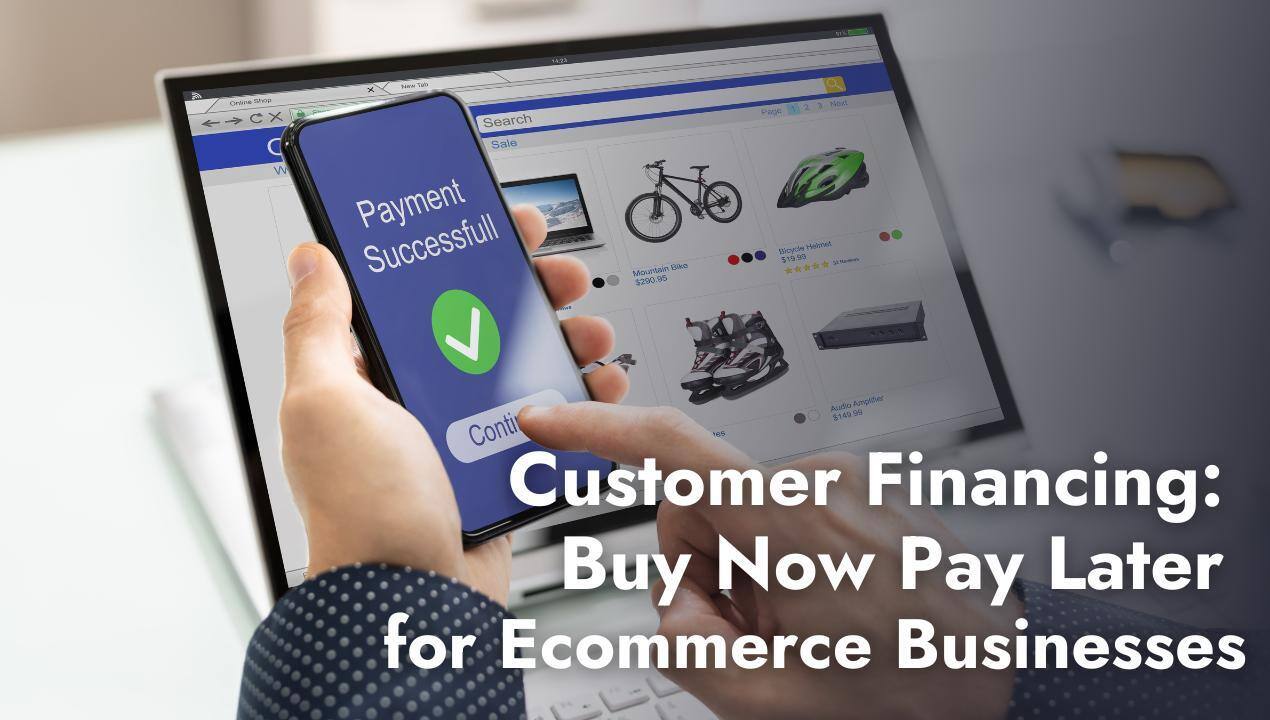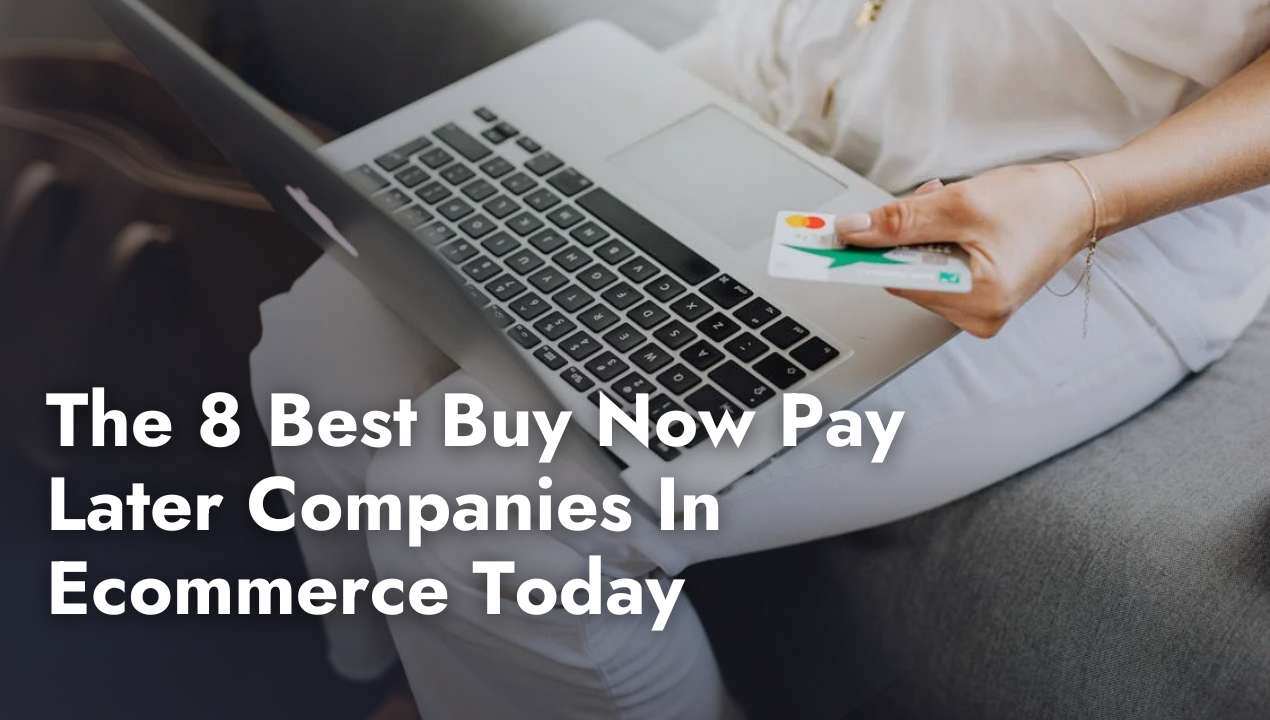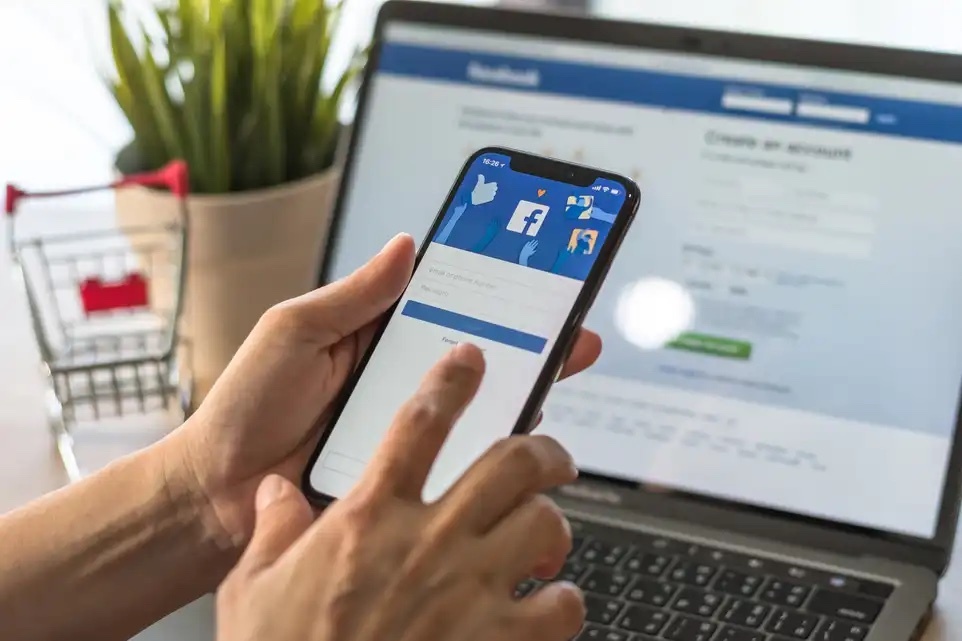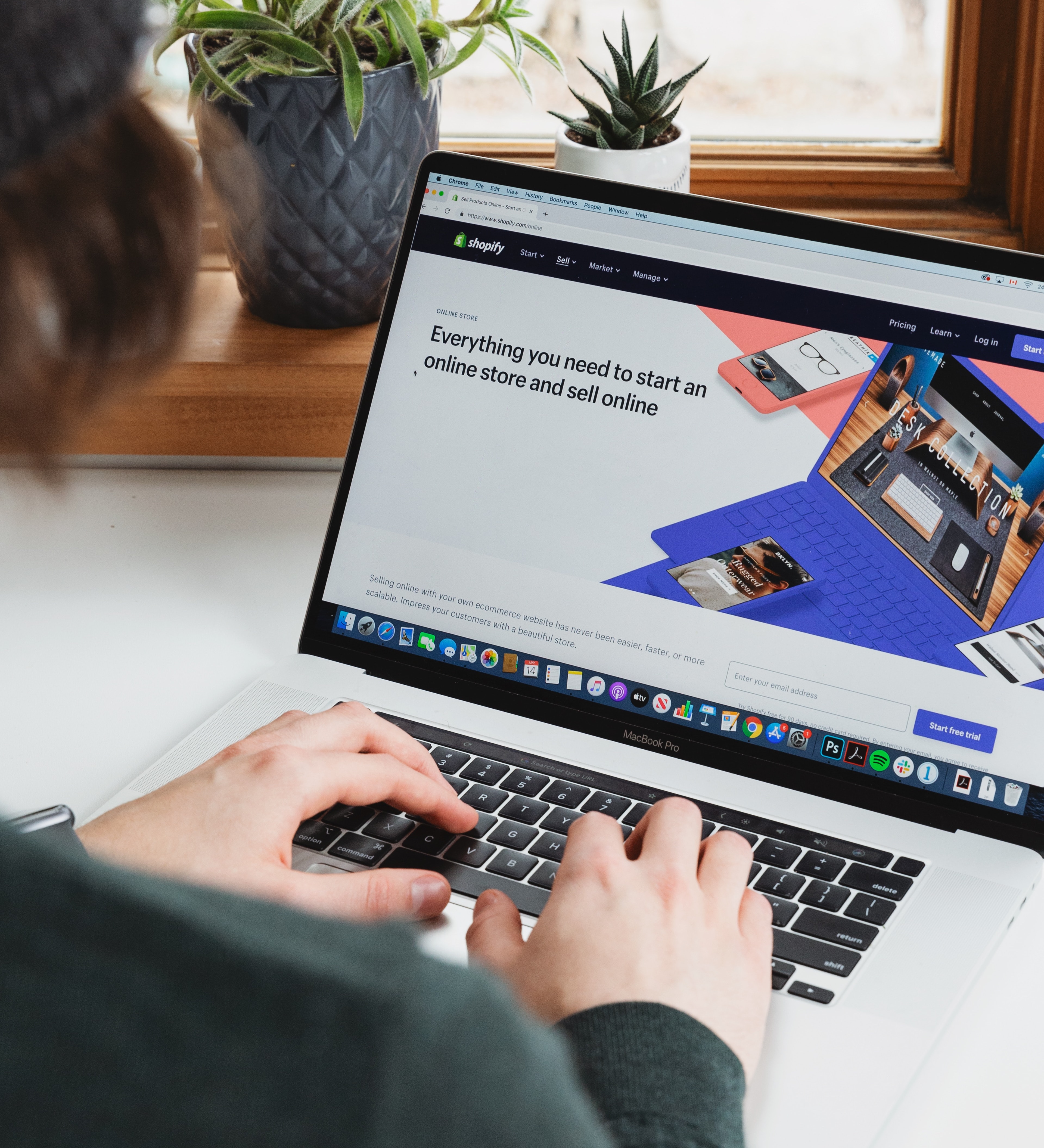Share this
Customer Financing: Offer Buy Now Pay Later as an Ecommerce Business
by Rin Mosher on Aug. 8, 2024

As an ecommerce business owner, you don’t want anything to stand in the way of a customer’s intent to make a purchase – but there are always going to be some factors that are out of your control. Economic hardship is one example, known to decrease demand by inclining people to cut back on spending. While you may not have power over the economy, you can make hitting that ‘Buy’ button easier with customer financing, often called Buy Now, Pay Later (BNPL).
This article explains alternative payment in ecommerce, the benefits of becoming a buy now pay later merchant, and how to set up financing for your customers.
What Is Customer Financing/Buy Now Pay Later (BNPL)?
Customer financing, also known as Buy Now Pay Later (BNPL), is a payment option that allows consumers to purchase goods or services and pay for them in installments over time. Although these arrangements may seem to work like regular bank loans, the key difference is BNPL options are approved online with a few clicks and are often interest-free for a set period – meaning online shoppers are much more inclined to use them.
Buy Now Pay Later In Ecommerce
Where well-established businesses like car dealerships and appliance stores have long offered customer financing in-house, ecommerce businesses are now implementing the option at checkout through their own payment programs and partnerships with third-party BNPL providers.
The latter arrangement is by far the most common amongst ecommerce businesses. Companies like Klarna and Afterpay aim to simplify the BNPL process for merchants and customers by seamlessly integrating with the ecommerce platforms businesses use to sell products online.
FIS' Global Payments Report states that BNPL accounted for five percent of ecommerce transaction volume last year. Juniper Research expects this payment method to grow in popularity, projecting that nearly a quarter of all global ecommerce transactions will be bought with BNPL by 2026.
How Buy Now Pay Later Works for Customers
With buy now, pay later arrangements, the lender (an ecommerce business for in-house financing or an outside company) fronts the cost of the purchase. The customer then repays the loan in installments, usually over a period of weeks or months. Unlike traditional loans, many BNPL options don't charge interest if paid within the agreed timeframe.
Installments are typically split into four and spread over six weeks. Some BNPL companies offer longer terms for large purchases, up to 39 months. Interest rates depend on the lender’s revenue model and the customer’s credit history. Today, most BNPL charge between 0% and 30% of the purchase total for every missed payment.
When a customer chooses a BNPL option at checkout, they typically undergo a quick credit check. If approved, they complete their purchase and pay a portion of the total cost upfront. The remaining balance is then divided into equal payments which are automatically charged to the customer's chosen payment method on set dates.
For example, a $200 purchase might be split into four payments of $50, with the first payment due at checkout and the remaining three spread over six weeks.
How Buy Now Pay Later Works for Ecommerce Businesses
BNPL lenders pay online stores the full purchase amount upfront on behalf of customers. The provider then assumes the risk of collecting payments – a process that is completely external from the ecommerce business. This arrangement ensures consistent cash flow for the business while offloading the administrative burden of managing installment payments.
However, BNPL services usually charge merchants a fee, which is typically a percentage of the transaction value. Yet despite the added cost, many businesses find that BNPL’s potential for increased sales volume and customer satisfaction outweighs the fees.

The Benefits of Offering Buy Now Pay Later
Buy now, pay later has equal appeal for ecommerce customers and sellers. On buyers' side, the option to spread purchase totals out over multiple weeks or months means being able to make purchases they might otherwise delay or forgo entirely. That creates positive conditions for increased sales and customer satisfaction, which businesses then benefit from. Below are more benefits your business can experience after making BNPL part of your online store's checkout process.
Minimal Work Required
The most worthwhile business decisions are those that require minimal effort to implement yet make a big impact toward goals. Buy now, pay later fits that criteria perfectly. Third-party lenders process applications, determine approvals, and manage loans for you – as a business, all you have to do is set up the checkout integration. Ecommerce companies can offer customer financing with little to no upfront investment or ongoing work while reaping all of the benefits we’ll cover next.
Reduced Cart Abandonment
BNPL options are known to help reduce cart abandonment, a common issue in ecommerce. Data from HotJar shows that three out of ten customers who fill online shopping carts actually make it to checkout. Price is one of the biggest causes of friction between browsing and buying. Customers may add items to their cart with enthusiasm, only to balk at the total cost when it's time to pay.
BNPL presents an alternative that feels more manageable. In the customer's mind, they're "only spending $50 today". While the full retail price will be charged, there's less of a perceived initial financial obligation. Financing can also determine whether someone who hasn't received their next paycheck buys today or waits until they have more funds.
Fewer Order Cancellations and Returns
The BNPL model also addresses another price-related pain point in ecommerce: buyer's remorse. Customers change their minds about purchases for a number of reasons, but cost is among the most common. When a customer makes a large purchase, they may experience anxiety or regret afterward, especially if it strains their budget. By spreading the cost over time, BNPL makes purchases feel more manageable. The reduced cancellations and returns that result benefit the business’s bottom line and brand reputation while lessening its reverse logistics workload.
Higher Average Order Values (AOVs)
Interestingly, giving consumers the option to break their purchases up into installments can result in higher average order values (AOVs). A recent study conducted by Stripe found that when presented with BNPL at checkout, customers weren't just more likely to complete a purchase – they were more likely to place large orders. Businesses saw increases in revenue of up to 14% as a result.
The thought is that when customers see smaller, more manageable payment amounts, they're more likely to add additional items to their cart or opt for higher-priced alternatives. BNPL similarly brings luxury and high-ticket items within more shoppers' reach. Under a normal payment model, a $1,000 product would only be sellable to people comfortable spending that amount all at once. When framed as ten $100 payments in a BNPL arrangement, the same item becomes accessible to a much larger audience.
Appealing to Young Shoppers
The recent popularization of customer financing options in ecommerce has prompted the question: what's driving the trend? According to the data, the answer is young people. In an article recently written for Forbes, a Senior Vice President at Ipsos claimed his firm's research shows younger users are more likely (48%) than older users (28%) to carry balances in BNPL programs.
Another piece of research suggests that 40% of Gen Z shoppers have used a BNPL solution within the last 90 days. The flexibility of BNPL aligns with the financial realities many young adults face, such as student debt, rising living costs, and gig economy income patterns. Offering customer financing can therefore facilitate sales to these individuals, which is especially appealing to ecommerce businesses that target younger demographics.
Potential Competitive Advantage
Before buy now, pay later, every ecommerce business was indiscriminately burdened by buyer hesitancy and sticker shock. Strong product page SEO, landing page optimization, and incentives were the most a business could do to strengthen its conversion rates. With accessible third-party financing solutions now in the picture, those offering BNPL have a significant competitive advantage.
Drawbacks Associated With Buy Now Pay Later Financing
Although offering a buy now, pay later option comes with many benefits, there are some risks that should be considered before partnering with a BNPL provider. They include:
Assignment of Liability
Although third-party lenders assume responsibility for managing BNPL loans, customers don't always know that. Ecommerce stores need to be very upfront about the separation between their business and the BNPL service. Customers should understand that while the ecommerce store facilitates the financing option, the actual loan agreement is between the customer and the BNPL provider. It's also wise to fully review ecommerce returns policies and add terms specific to BNPL purchases where necessary.
As regulations surrounding BNPL continue to evolve, so too will ecommerce businesses' options for marketing and offering such services. It's up to companies to stay on top of any changes from the Consumer Financial Protection Bureau (CFPB) as they're rolled out.
Multi-Step Integration Process
BNPL solutions are meant to be easy to deploy. However, there's still room for confusion during the setup process. First, merchants must meet the third-party company's criteria. Requirements are usually minimal but may include a minimum monthly sales volume, a certain number of years in business, or specific product categories.
Implementing BNPL checkout involves adding a plugin or API to your ecommerce platform. This process varies depending on your platform and chosen BNPL provider. Shopify has built-in integrations with several BNPL services, making setup in its system relatively straightforward. Other platforms may require more manual configuration.
Once the technical integration is complete, you'll need to update your website to reflect the new payment option. This includes adding BNPL information to product pages, cart summaries, and checkout screens.
Complex and Elongated Refunds
With the introduction of a third-party into ecommerce transactions comes more complexity across the board, particularly in the area of returns. BNPL providers aren't involved in fulfillment or reverse logistics, so the facility customers send their unwanted products to doesn't change. What does change is how refunds are handled and how long the process takes. Every BNPL provider has its own system with unique protocols and timelines.
In the case of the well-known lender Affirm, shoppers must request a refund from the merchant and continue to make payments until the seller approves their return. Funds are then reimbursed by Affirm within 10 business days. While timelines vary, it's always a multi-step process where the ecommerce business first sends the refund to the BNPL provider, and the BNPL provider forwards the portion of the loan paid for so far to the customer.
Online stores can – and as mentioned before, should – set clear policies on the buyer, seller, and third-party company's responsibilities for returns and refunds on their websites. The extra work of establishing a clear system explaining the interplay between both businesses' policies slows the setup process but is pivotal to avoiding disputes down the line.
Increased Customer Service Demands
While BNPL can boost sales, it also introduces new customer service challenges. Merchants may need to handle inquiries about payment plans, interest rates, and repayment schedules. This ties back to the importance of clearly differentiating the roles of the merchant and third-party BNPL company.
High Fees
Virtually all payment gateways used in ecommerce today have fees. Some only impose them on the seller, while others charge both the seller and the buyer. Traditional credit card processing fees, for example, typically range from 1.5% to 3.5% of each transaction. BNPL services, however, often come with higher costs for merchants – anywhere between 1.5% and 7% of a customer’s total purchase.
BNPL companies justify that jump with the argument that their instant credit decisions and interest-free periods come with additional financial risk. As an ecommerce business, offering customers the flexibility of BNPL means fronting those higher fees, which may or may not be worth it depending on how much value buyers see in financing.
Customer Discontent
Just like credit cards, not everyone is as responsible as they should be with BNPL loans. When people have more flexibility, they're inclined to overextend themselves. LendingTree reports that almost 70% of BNPL buyers admit to spending more than they would if they had to pay for their entire purchase upfront. The consequences of doing so can also result in secondary fees charged to the borrower, such as overdraft, non-sufficient funds, and late fees.
This impacts ecommerce businesses' customer experience and brand perception. Even if someone knows the merchant that sold them a product and the BNPL provider that financed their purchase are separate entities, they may still develop a negative opinion and shop elsewhere in the future.
How to Set Up Customer Financing as an Ecommerce Seller
Despite the potential challenges outlined above, many ecommerce businesses find that the benefits of offering BNPL outweigh the risks. It's simply a matter of thoughtful implementation. A well-devised plan can simplify the setup process while minimizing potential pitfalls. Here's a step-by-step guide to setting up customer financing for your ecommerce business:
Assess Your Business Needs
Evaluate your current sales data, average order value, and customer demographics to determine if BNPL aligns with your business goals. In consideration of the benefits and drawbacks, is customer financing worth the time and effort? If you're reading a step-by-step breakdown on how to set up customer financing, the answer is probably yes. But it's still worth taking time to reflect upon what matters most in your specific case scenario, as it will influence the BNPL partner you choose. For instance, if you're a high-end retailer selling luxury goods, you might prioritize providers that offer higher credit limits and longer repayment terms.
Choose a BNPL Provider
Buy now pay later solutions exist for both DTC and B2B sales models. Most ecommerce stores sell to consumers, and will therefore pick from options in the former category, such as Affirm, Klarna, Afterpay, Sezzle, etc. However, some lenders offer both DTC and B2B/wholesale services – hence the importance of research. Transaction fees, payment terms, credit check processes, and fraud protection should also be top of mind.
However, with customer experience being on the line, it's equally imperative to consider the reputation of the BNPL provider among both consumers and other ecommerce businesses. Payment terms can provide a window into each lender's stringency – or lack thereof – as well as their overall reliability.
Integrate BNPL Into Your Ecommerce Site
This next step will look different depending on the buy now pay later partner you have chosen to work with. Most BNPL providers offer plugins or APIs for popular ecommerce platforms like Shopify, WooCommerce, and Magento.
The integration process usually goes as follows:
- Sign up for an account with your chosen BNPL provider
- Install their plugin or add their API to your ecommerce platform
- Configure settings like minimum purchase amount and payment terms
- Test the integration to ensure smooth functionality
Those with custom-built ecommerce sites may need to work with a developer. Ensure that the BNPL option appears correctly, functions smoothly, and doesn't interfere with other payment methods.
Update Your Ecommerce Website to Reflect Changes
Lastly comes the tedious but critical step of updating your checkout flow and website content. Clearly display the BNPL option alongside other payment methods during checkout, and don’t forget to create informational pages or FAQs explaining how the BNPL service works, including eligibility requirements, payment schedules, and any potential fees or interest charges.
To drive uptake from shoppers, you could even update product pages to highlight the availability of BNPL. Presenting estimated monthly payments for higher-priced items can make products seem more affordable and increase conversion rates.
Take this Blender Brush product page from Westman Atelier as an example:

Fulfillment Is Just as Important as Customer Financing
Offering customer financing through buy now pay later is only one of many ways ecommerce sellers can invigorate online shoppers’ experiences. Post-checkout solutions hold just as much importance – if not more – to repeat sales.
Shipfusion has every third-party logistics (3PL) solution you need to cultivate satisfaction at scale. Growing ecommerce businesses trust us for inventory management, order fulfillment, freight forwarding services, returns management, and more because they trust our reputation for industry-leading performance.
99.9% order accuracy and 99.9% SLA attainment don’t happen by accident – discover why Shipfusion is the best 3PL in the industry by contacting our team today.
Share this
You May Also Like
These Related Articles

The 8 Best Buy Now Pay Later Companies In Ecommerce Today

How to Sell On Facebook as a Business In 2025

Best Ecommerce Platforms for Small Businesses
- April 2025 (23)
- March 2025 (26)
- February 2025 (26)
- January 2025 (37)
- December 2024 (16)
- November 2024 (23)
- October 2024 (22)
- September 2024 (27)
- August 2024 (9)
- July 2024 (8)
- June 2024 (5)
- May 2024 (8)
- April 2024 (8)
- March 2024 (6)
- February 2024 (6)
- January 2024 (5)
- December 2023 (3)
- November 2023 (3)
- October 2023 (5)
- September 2023 (4)
- August 2023 (2)
- July 2023 (1)
- June 2023 (4)
- March 2023 (2)
- October 2022 (1)
- September 2022 (5)
- August 2022 (4)
- July 2022 (7)
- June 2022 (4)
- May 2022 (4)
- April 2022 (6)
- March 2022 (2)
- February 2022 (1)
- January 2022 (3)
- December 2021 (2)
- November 2021 (4)
- October 2021 (2)
- September 2021 (5)
- August 2021 (4)
- July 2021 (4)
- June 2021 (3)
- May 2021 (2)
- April 2021 (3)
- March 2021 (3)
- February 2021 (3)
- January 2021 (2)
- December 2020 (4)
- November 2020 (2)
- October 2020 (4)
- September 2020 (2)
- July 2020 (5)
- June 2020 (4)
- May 2020 (2)
- April 2020 (2)
- March 2020 (4)
- February 2020 (1)
- December 2019 (1)
- May 2018 (1)
- March 2018 (2)
- February 2018 (3)
- January 2018 (3)
- November 2017 (3)
- July 2017 (4)
- March 2017 (3)
- February 2017 (5)
- January 2017 (3)
- December 2016 (4)
- November 2016 (6)
- October 2016 (6)
- October 2015 (1)
- September 2015 (1)
- June 2015 (3)
- May 2015 (3)
- August 2014 (1)
- July 2014 (1)
- March 2014 (1)
- February 2014 (1)